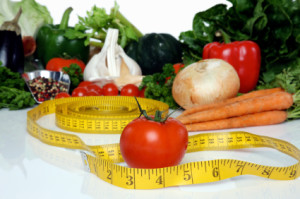Pushing through a weight-loss plateau
 It’s a familiar experience for dieters with a goal – progress stops even though you’re sticking with the program. If you’re losing weight, seeing your waist shrink or your gut disappear is the ultimate motivator. When the downward trend suddenly stops for no apparent reason – known as a weight-loss plateau – disappointment may discourage you. The key to success is powering through each obstacle.
It’s a familiar experience for dieters with a goal – progress stops even though you’re sticking with the program. If you’re losing weight, seeing your waist shrink or your gut disappear is the ultimate motivator. When the downward trend suddenly stops for no apparent reason – known as a weight-loss plateau – disappointment may discourage you. The key to success is powering through each obstacle.
Why a weight-loss plateau happens
A weight-loss plateau may be caused by a change in your metabolic rate. At the beginning of a diet-and-exercise routine, stored glycogen with bound water is mobilized to meet energy needs. Some of the initial weight lost is water. As your body adjusts to your reduced caloric intake, metabolism slows, which translates into fewer calories burned. Increasing exercise will maintain or increase your metabolic rate. To continue losing weight, exercising persistently will help continue your weight reduction.
Sometimes, increasing intensity or frequency of exercise still doesn’t drop weight. To move beyond this type of plateau, careful analysis of your situation usually helps.
What’s the Problem?
 Something you’re eating or a lifestyle habit you’ve developed may be holding you back. Examine every element of your diet. Wine, beer, and mixed drinks are a ready source of extra calories. Food technology has developed very low calorie substitutes for nearly all staple foods. High protein foods tend to be more fulfilling of appetite. Fish, poultry, lean meat, and fat free dairy products are all protein dense and low in calories. Limiting carbohydrates is important to minimize insulin levels, the hormone that stores energy in fat cells.
Something you’re eating or a lifestyle habit you’ve developed may be holding you back. Examine every element of your diet. Wine, beer, and mixed drinks are a ready source of extra calories. Food technology has developed very low calorie substitutes for nearly all staple foods. High protein foods tend to be more fulfilling of appetite. Fish, poultry, lean meat, and fat free dairy products are all protein dense and low in calories. Limiting carbohydrates is important to minimize insulin levels, the hormone that stores energy in fat cells.
Green vegetables are “free selections,” meaning they are guilt free. You can eat all of the spinach, lettuce, cauliflower, broccoli, asparagus, and other greens you want. Add seasoning, citrus, hot sauce, or balsamic for flavor. Avoid high carbohydrate vegetables, such as potatoes, corn, rice, squash, and beets. Avoid sauces and creamy dressings, both calorie-dense. Check nutrition labels on all packaged foods to know what your eating.
Medical and Surgical Options
If you’re watching your diet closely but are still stuck above your goal weight, prescription or non-prescription appetite suppressant medications can help you further diminish intake. Controlling hunger results in fewer meals, and smaller portions at each meal. Forget about desserts. Eat to survive, not for pleasure. Imagine yourself an athlete in training, and eschew the high-calorie foods offered at most social gatherings. Although not for weight loss, liposuction can remove bulges that remain once you get to your desired weight. Stubborn fat just beneath the buttocks — known as banana rolls — is a common concern for patients at this stage. The most frequently treated regions include the waist, flanks, inner and outer thighs, and buttocks. Weight loss surgery, such as lap-band or gastric bypass, is reserved for the most severely overweight or obese who are repeatedly unable to achieve stable, long-lasting weight control by any other measures.
For more information or a personalized evaluation and/or recommendations, call Dr. Laverson’s office at 858-295-4001, or e-mail amber@feelbeautiful.com.

 Book Now
Book Now












